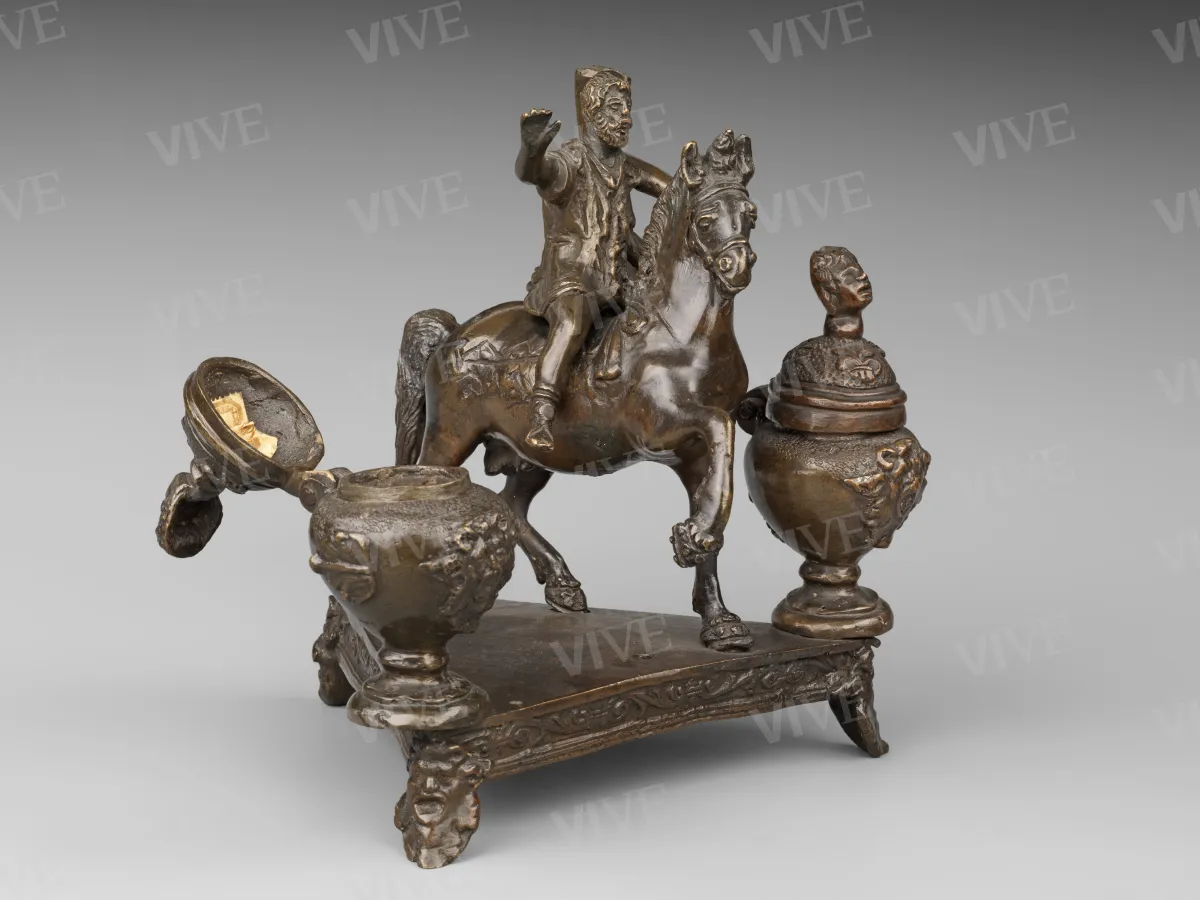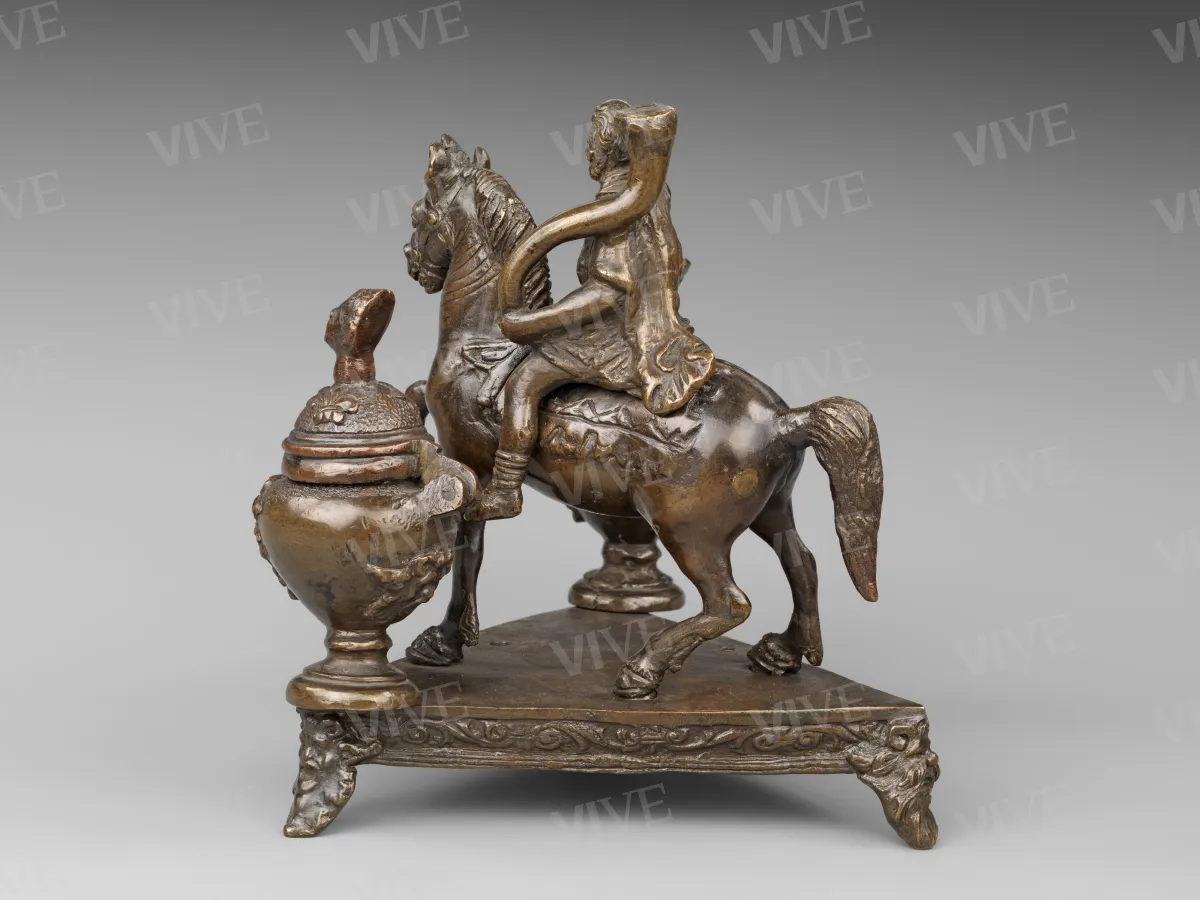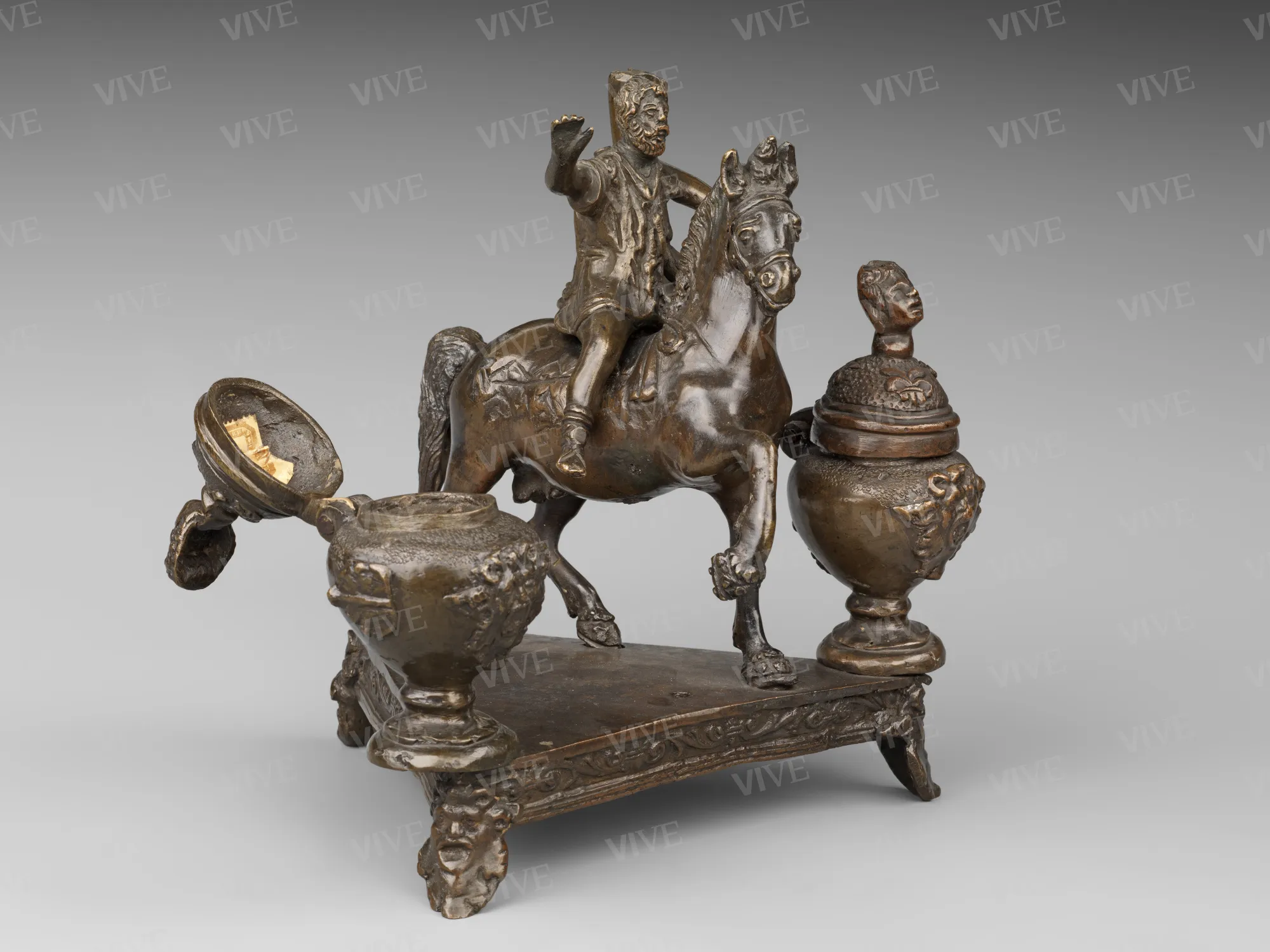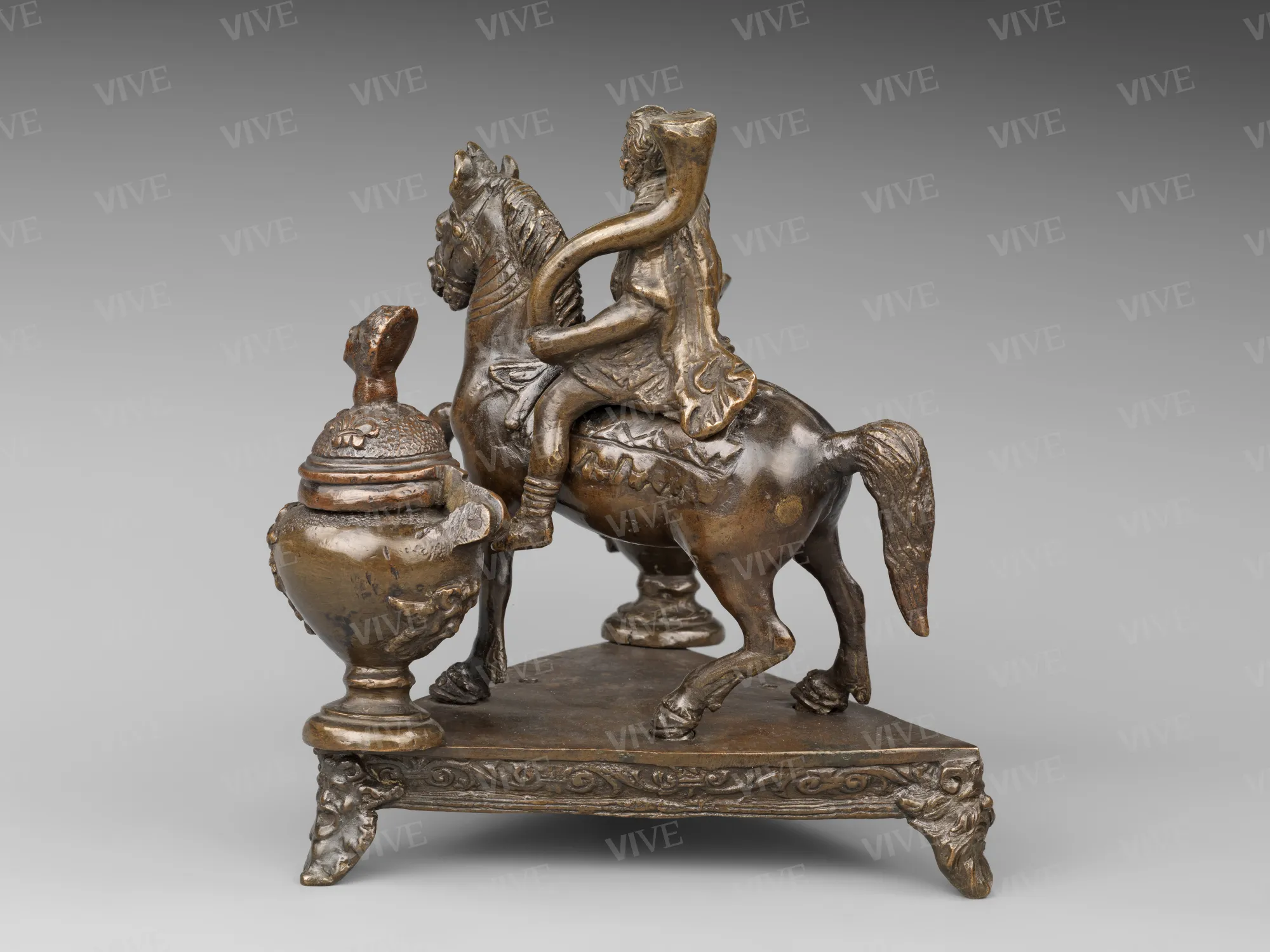Marcus Aurelius Inkwell
Workshop of Severo Calzetta da Ravenna 1510–1530 (the model)
The small bronze is modeled after the well-known equestrian statue of Emperor Marcus Aurelius in Rome, transforming the historical subject into a practical item with a pen holder (the cornucopia), a powder box, and an inkwell (the two vases). The design for the inkwell was created by Severo Calzetta da Ravenna, although this particular example, likely made in his workshop, is not as refined. The workshop continued to produce items for an extended period after the master's death.
The small bronze is modeled after the well-known equestrian statue of Emperor Marcus Aurelius in Rome, transforming the historical subject into a practical item with a pen holder (the cornucopia), a powder box, and an inkwell (the two vases). The design for the inkwell was created by Severo Calzetta da Ravenna, although this particular example, likely made in his workshop, is not as refined. The workshop continued to produce items for an extended period after the master's death.
Details of work
Catalog entry
The small bronze sculpture, from the Alfredo Barsanti Collection, is a scaled-down reproduction of the well-known equestrian statue of Emperor Marcus Aurelius in Rome (Sommella, Parisi Presicce 1997, 38, cat. 19). The rider, dressed in period attire, extends his right arm forward with his palm raised and fingers clenched. His other hand, placed near his left hip, holds a long cornucopia that originally held a pen. The group is mounted on a triangular base supported by grotesque masks and features two large vases (an inkwell and a powder box) at its corners, which are decorated with monstrous protomes and Moor’s heads on the lids. The composition is somewhat rough, with bold incisions depicting the facial features of Marcus Aurelius, the horse's anatomy, and its harness.
There are more than twenty documented instances of this bronze group, each exhibiting minor variations in the design of the cornucopia, the inkwell and powder box (occasionally omitted), as well as differences in the base and feet.The various attributions of this work have been the subject of a complex and inconsistent critical debate. Jolán Balogh and Norberto Gramaccini attributed its production to a northern Italian workshop in the early sixteenth century (Balogh 1966, 279; Gramaccini 1985, 356–357, cat. 55–57), whereas Pollak preferred to confine it to the Padua area (Pollak 1922, 56, n. 39). Other scholars have attributed it directly to individual sculptors or their workshops. Horace Townsend proposed an attribution to Bertoldo di Giovanni (Townsend 1920, cat. 287); the anonymous cataloguer of the Tolentino sale linked it to Bartolomeo Bellano; Fritz Goldschmidt, Stefano Bardini, and Wilhelm Bode associated it with the circle of Andrea Briosco, known as il Riccio (Goldschmidt 1914; Bardini 1918, cat. 97; Bode 1930). The most recent and widely accepted opinion among scholars is that of Patrick De Winter, who attributed the work to the workshop of Severo Calzetta (De Winter 1986, 101–102). Indeed, the piece exhibits the characteristic features of the Ravenna master's style, from the physiognomy of the knight to the rendering of the drapery.
Around the 1510s, Calzetta likely created a prototype that was replicated many times by his collaborators. The workshop continued to operate after his death, repeating his designs beyond the mid-sixteenth century and sometimes combining different elements. It is probable that the two large containers on either side of the horse were not originally part of the composition (Cannata 2011, 54–55, cat. 50). Since no high-quality example has survived to confirm the direct authorship of the master craftsman, the original appearance of the model cannot be determined. Severo may have created the prototype without directly referencing the Roman bronze, instead reworking reductions of the monument made by other artists from the mid-fifteenth century onwards. For example, at the Gonzaga court with which he was associated in the 1520s, both Filarete’s fifteenth-century Marcus Aurelius and the one recently made by Jacopo Alari Bonacolsi, known as “l’Antico” (Jestaz 2002, 315; Ferrari 2008, 317–318, doc. 86), were preserved.
Marco Scansani
Entry published on 12 June 2025
State of conservation
Good.
Provenance
Rome, Collezione Alfredo Barsanti, 1934;
Rome, Museo Nazionale di Palazzo Venezia, 1934.
References
Goldschmidt Fritz, Königliche Museen zu Berlin: Beschreibung der Bildwerke der christlichen Epochen. Die italienischen Bronzen der Renaissance und des Barock: Büsten, Statuetten und Gebrauchsgegenstände, Berlin 1914;
Bardini, in De Luxe Illustrated Catalogue of the Beautiful Treasures and Antiquities Illustrating the Golden Age of Italian Art Belonging to the Famous Expert and Antiquarian Signor Stefano Bardini of Florence: New York 23-27 April 1918, Anderson Galleries, New York 1918;
De Luxe Catalogue of the Rare Artistic Properties Collected by Raoul Tolentino: New York, 21-27 April 1920, Anderson Galleries, New York 1920 ;
Pollak Ludwig, Raccolta Alfredo Barsanti, Roma 1922;
von Bode Wilhelm, Staatliche Museen zu Berlin, Bildwerke des Kaiser-Friedrich-Museums. Die italienischen Bildwerke der Renaissance und des Barock. Zweiter Band. Bronzestatuetten. Büste und Gebrauchsgegenstände, Berlin 1930;
Balogh Jolán, Studi sulla collezione di sculture del Museo di belle arti di Budapest, in «Acta historiae artium Academiae Scientiarum Hungaricae Magyar Tudományos Akadémia», XII, 1966, pp. 211-346;
Gramaccini, in Beck Herbert, Blume Dieter (a cura di), Natur und Antike in der Renaissance, catalogo della mostra (Francoforte sul Meno, Liebieghaus, 5 dicembre 1985-2 marzo 1986), Frankfurt am Main 1985, pp. 356-357, catt. 55-57;
De Winter Patrick, Recent Accessions of Italian Renaissance Decorative Arts, Incorporating Notes on the Sculptor Severo da Ravenna, in «The Bulletin of the Cleveland Museum of Art», LXXIII, 1986, pp. 75-138;
Sommella Anna, Parisi Presicce Claudio, Il Marco Aurelio e la sua copia, Cinisello Balsamo 1997
Jestaz Bertrand, Bronzo e bronzetti nella collezione Gonzaga, in Morselli, Raffaella, Emiliani Andrea (a cura di), Gonzaga: la Celeste galeria, le raccolte, catalogo della mostra (Mantova, Palazzo Ducale; Palazzo Te, 2 settembre-8 dicembre 2002), Milano 2002, pp. 313-329;
Ferrari Daniela, L’Antico nelle fonti d’archivio, in Trevisani Filippo (a cura di), Bonacolsi l’Antico, uno scultore nella Mantova di Andrea Mantegna e di Isabella d’Este, catalogo della mostra (Mantova, Palazzo Ducale, 13 settembre 2008-6 gennaio 2009), Milano 2008, pp. 300-328;
Cannata Pietro, Museo Nazionale del Palazzo di Venezia. Sculture in bronzo, Roma 2011.














